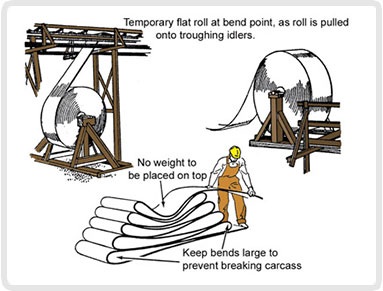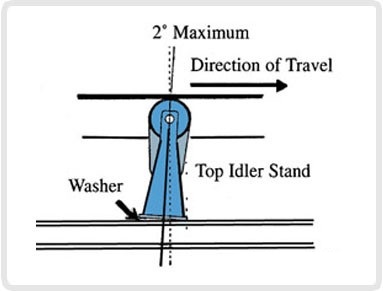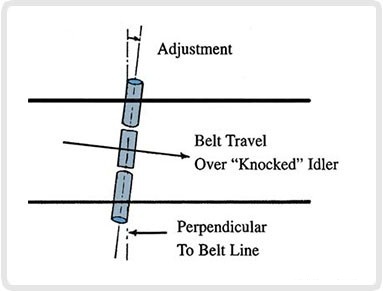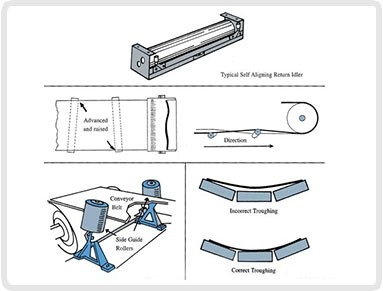- D-136,Shankar Road, New Delhi - 110060, India
- +91 88 266 79660
- universal(at)hic-india(dot)com
HIC Perú Latinoamérica goma cubierta Guía poleas intermedias vaguada por
Industrias del Perú, España, Mexico, Colombia, Guinea Ecuatorial, Argentina, Venezuela, Chile, Ecuador, Bolivia, Paraguay, América del Sur utilizando ociosos transporte tubos acero con anillos goma para manejar materiales rodillos, cintas transportadoras tambor cabeza y cola selección instalación poleas guía para obtener una larga vida para el transporte arena, rocas, minerales, alimentos, granos, envasados bolsas.
- Brea o el espaciamiento la ejecución la polea fija mínimo 1 metro, en general por hacer para la alta eficiencia del sistema transporte cinturón
- Derrame material en la zona carga del ser limpiado periódicamente para proteger la polea cáscara, cinturón cubrir los daños y alto consumo energía.
- Colisión o pinzamiento en cola-polea y la adopción la zona hay que tener cuidado evitar daños.
- Punto alimentación debe tener 4a-5o conjuntos caucho rezagado Impacto ociosos en 500-750mm distancia para proteger a los principios alto valor Belting daños.
- Material construcción utilizados son resultado la Vivienda CRCA Acero, Shell la EM como la cañería por IS9295, eje EN8, sellado doble laberinto agua y polvo, aprovechar la reputación Rodamientos resistentes.
- * La variación en el tamaño como por MFG tolerancias dimensionales deben ser aceptables
How to Install Carrying Idler
All carrier idlers should initially be squared with the path of the belt and only the minimum shifting of idlers used as a training means. If the belt is over-corrected by shifting idlers, it should be restored by moving back the same idlers, not by shifting additional idlers in the other direction.
Obviously such idler shifting is effective for only one direction of belt travel. If the belt is reversed, a shifted idler, corrective in one direction, will misdirect in the other. Hence reversing belts should have all idlers squared up and left that way. Any correction required can be provided with self-aligning idlers designed for reversing operation. Not all self-aligners are of this type, as some work in one direction only.
Tilting the troughing idler forward (not over 2°) in the direction of belt travel produces a self-aligning effect. The idlers may be tilted in this manner by shimming the rear leg of the idler stand. Here again this method is not satisfactory where belts may be reversing.
Return Idlers Installation Method
Return idlers, being flat, provide no self-aligning influence as in the case of tilted troughing idlers. However, by shifting their axis (knocking) with respect to the path of the belt, the return roll can be used to provide a constant corrective effect in one direction. As in the case of troughing rolls, the end of the roll toward which the belt is shifting should be moved longitudinally in the direction of return belt travel to provide correction.
Self-aligning return rolls should also be used. These are pivoted about a central pin. Pivoting of the roll about this pin results from an off-center belt and the idler roll axis becomes shifted with respect to the path of the belt in a self-correcting action. (Figure 6) Some return idlers are made with two rolls forming a 10° to 20° V-trough, which is effective in helping to train the return run.
A further aid to centering the belt as it approaches the tail pulley may be had by slightly advancing and raising the alternate ends of the return rolls nearest the tail pulley.
When to Install Side Guide Rollers
Guide roller be used to afford the protection to the belt as an emergency measure, provided that they do not touch the belt edge when it is running normally. If they bear on the belt continually, even though free to roll, they tend to wear off the belt edge and eventually cause ply separation along the edge. Side guide rollers should not be located so as to bear against the belt edge once the belt is actually on the pulley. At this point no edge pressure can move the belt laterally.
HIC Cooperación Internacional la Marca Calidad UNIVERSAL Fabricado acero y rodillos goma combinar la polea se sustituye 8598 Magnífica Vivienda y sistema cierre aspecto Ventaja asegura larga vida Fiabilidad.
Gracias por la compra productos transporte UNIVERSAL Usted seguro deseos y Movimiento Materiales.
Descargo responsabilidad: La información es, por escrito y verbales son proporcionados por HIC, en relación a sus productos que se determina a no ser fiables y pasivos cualquier naturaleza en cuanto a sus usos. El comprador los productos industriales UNIVERSAL marca debe determinar por sí mismo la idoneidad dichos productos
HIC Peru Latin America Rubber Covered Troughing Idlers Guide
Conveyor 3 roll rubber covered troughing idlers and drum pulley suppliers to industries of Peru, Spain, Mexico, Colombia, Equatorial Guinea, Argentina, Venezuela, Chile, Ecuador, Bolivia, Paraguay in South America and other parts of Latin America located factories using belt carrying idlers of steel pipe with rubber rings rollers to handle materials, belt conveyors rubber lagged head pulley and tail pulley Selection Installation Fitting guide to get long life for transporting sand, rocks, ores, food-grains, packed bags.
Useful Links
- Conveyor rollers & pulleys india Clients
- Conveyors steel idler rollerManufacturers Specifications
- Carrier rollers specs
- Belt conveyor trough Impact rollers
- Return conveyor-idler
- Material Handling conveyor system Pulleys specs
- Conveyor rollers EnquiryForm
- Conveyor belting pulleys Enquiry Form
- Drive rollers manufacturingcompany Profile
- HIC roller-conveyorResearch &development
- Universal brand conveyor idler Range
- Material handling conveyor-Idler Technical Data
- Head Drum, Tail drivePulleys Technical Data
- Hic make conveyor-rollersIndustrial Application
- Hic make conveyors pulleyIndustrial Application
- Conveyors idler-roller industrial Supplies
- Steel roller conveyors products Catalog






